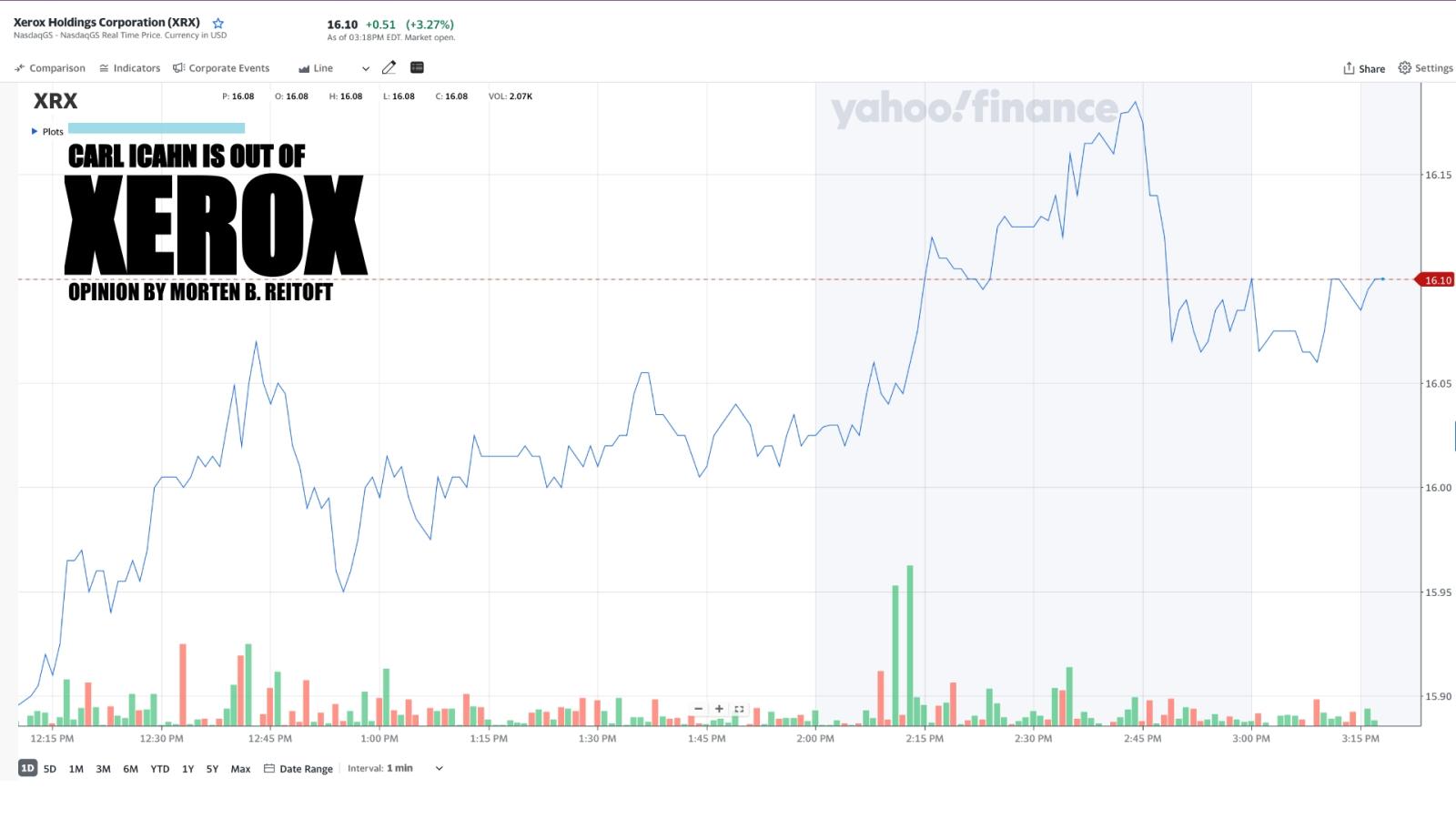Congratulations. Today is an excellent day for Xerox, as the company finally gets rid of Carl Icahn, who, in my view, has destroyed Xerox and the opportunity the company had with Fujifilm to become one of the most prominent and most influential companies in the graphic arts industry. Now, Xerox bought back Icahn shares for $542 million, and a new Chairman of the Board has been appointed, Scott Letier.
Xerox CEO Steve Bandrowczak credits Icahn for his 'invaluable counsel, guidance and activism.' I am not sure how much that is from the heart or what to expect when a large investor leaves a company like Xerox - but as they have agreed on these deals, I believe it's because the management and the board conclude this is better for shareholders, customers, and the company.
From the outside, it seems that Icahn has nothing but ruined the position of Xerox as a flagship in an industry that essentially gave birth to digital printing and made Xerox an incomparable icon.
When Icahn forced the breakup with Fujifilm, it fueled Fujifilm to go all in on their new brand Revoria, which essentially could rebrand what we used to know as the Xerox Iridesse and other printers with a new badge, terminate distribution agreements in several countries, and start selling, building up a slightly modified Iridesse and compete head to head with Xerox. I don't know anything about the R&D at Xerox. Still, it's a fact that the Baltoro and the iGen are the two remaining products of Xerox in the production environment, and everybody expects Xerox to deliver something new to adapt to a unique situation where R&D doesn't come from Fujifilm in Japan. What they will bring is still unknown, but it needs to be great, and Xerox needs to do it fast!
I am delighted with the new situation, though it's complicated. But congratulations, Xerox; I believe this is great, and I don't know what tomorrow will bring you, but it could be either a revival or a sell - let's see!
The stock market reactions are also positive - Xerox's market cap increased by almost 4% the first hours after the stock exchange's opening, yet lower than previous and glorious all-time high share prices - it's convincing!
So, let's move to some speculations in the market. Xerox is not exhibiting at drupa, which has led to many questions. I called Xerox to see if I could get a statement, but they haven't returned my call yet, so I will speculate and hopefully revert if/when I get updates!
Whether Xerox is on its way in or out of production print has, in my mind, nothing to do with whether they exhibit at drupa or not. Drupa is expensive, and if you don't have anything new to show, why spend millions of Euros? If you have no distribution, as Revoria has taken dominant European geographies, why exhibit and expose a potential weak point? Last, the customer acquisition cost is so high at drupa that maybe the real question should be how can anybody else justify their drupa expenses?
And then we come to something else.
Why have Xerox and other companies been on all previously announced lists of drupa exhibitors? Have they initially signed an agreement and then bailed from it? Or could it be that drupa took exhibitors who have not explicitly said no to exhibit on their lists to convince others that drupa is a good investment and that they need to be there because their competitors are there? It's not a pleasant speculation, but why have exhibitors on a list that haven't signed up for a booth space, and when we downloaded the most recent list, why have other exhibitors ALSO disappeared from previously published lists?
Can we expect more companies from the current drupa list to disappear? And if we look at the list, what should visitors expect? Well, for sure, the number of exhibitors is lower than in 2016, but what is more of a concern, and what we have also written before, is that the number of German exhibitors is much lower. Though the number of Chinese exhibitors is lower than in 2016, they represent a more significant number of exhibitors in 2024. This is significant as European visitors - and last time, 68% of all the visitors were European, and I don't believe Europeans are very interested in Chinese products. In 2016, 3% of the visitors were from the US before the first PRINTING United was held in Dallas in 2019. With a stronger, larger, and membership-owned show like PRINTING United - this time in Atlanta - will that attract a smaller or larger US audience to drupa? Your guess is as good as mine, but my guess is NO.
And that leads me to my last speculation about drupa for this time. If you can't attract enough European and North American printers and have many Chinese vendors, how can you make it worthwhile for them to exhibit at the almighty drupa? Well, Latin American printing companies invest in Chinese and Indian products so that a strategy could attract more visitors from Latin America.
But that's another story that we might tell you more about later :-)



Fri October 15th
Abundância de provas...
O Que Os Papéis Dizem-Semana de 11 de outubro-Por Nessan Cleary
Fri October 8th
A Austrália ainda es...
O Que Os Papéis Dizem-Semana de 4 de outubro-Por Nessan Cleary
Fri October 1st
A cobertura desta se...
O Que Os Papéis Dizem-Semana de 27 de setembro-Por Nessan Cleary
Fri September 24th
Mais sinais de cresc...
O Que Os Papéis Dizem-Semana de 20 de setembro-Por Nessan Cleary
Tue September 21st
A experiência de imp...
INKISH cobre o evento, e mal pode esperar para conhecer a indústria é este talvez primeiro evento físico na Europa:-)
Fri September 17th
Há boas notícias sob...
O Que Os Papéis Dizem-Semana de 13 de setembro-Por Nessan Cleary
Sat September 11th
Perguntas sobre o es...
O Que Os Papéis Dizem-Semana de 6 de setembro-Por Nessan Cleary
Fri September 3rd
Estas semanas histór...
O Que Os Papéis Dizem-Semana de 30 de agosto-Por Nessan Cleary
Fri August 27th
Pesquisadores encont...
O Que Os Papéis Dizem-Semana de 23 de agosto-Por Nessan Cleary
Wed August 25th
Você nunca vai inves...
O que faz PSPs relutar em investir?
Assine
Receba Notificações para se inscrever em nosso informativo
Login (login)
Novo Usuário (novo_usuário)? Registre-se (registre)
Apague Senha (apague_senha)
Registre-se (registre)
Usuário Existente (existente_usuário)? Login aqui (login_aqui)
Login aqui (login_aqui)
Apague Senha (apague_senha)
Por favor entre seu endereço de email registrado Você receberá um link para resetar a sua senha via email (rest_senha_descrição)
Novo Usuário (novo_usuário)? Registre-se (registre)